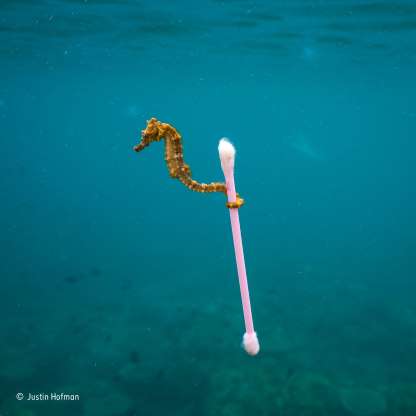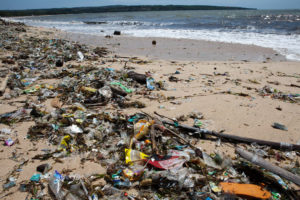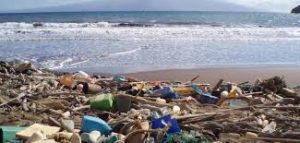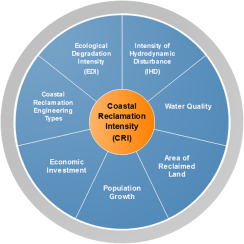Trashing the Ocean : A Well Thought Out Scream by James Riordan

The above photograph says it all. At first it seems cute. There are few things out there as cute as a seahorse. Then you realize that what the little thing is holding onto is a pink plastic cotton swab often called a Q-tip after the original manufacturer’s product name. You know like facial tissues of all kinds are often called Kleenex. In this case the California based nature photographer, Justin Hoffman was nominated for London’s Natural History Museum’s Wildlife Photographer of the Year. Hoffman says he wishes the photo didn’t exist. “I wish we didn’t have to see this beautiful wildlife mixed in with all of our waste,” he said. “I travel all over the world, and I can’t think of a single place where people haven’t impacted the environment.”
The competition’s winners will be announced on October 17. Hoffman said he hopes his photo will prompt people to think about making more environmentally friendly decisions. “At night when I am laying in bed, I don’t feel very optimistic, but I have to be, or otherwise there would be no reason to keep doing what I do,” he said.
The photo highlights how plastic pollution has left virtually no corner of our world untouched. Hoffman, who is snapped the photo while snorkeling near Subawa Island, Indonesia last year. He said his friend pointed out the sea horse, which was holding onto a piece of seaweed and drifting with the current. “When the tide came in, the debris came in with it, and the seahorse hopped from the seaweed to a little piece of plastic and then a Q-tip,” he said. Hofman said his “blood was boiling,” but he continued to snap pictures. “I took the photo in Indonesia, but this is happening everywhere in the world,” he said. He said that many people in Indonesia are horrified by the pollution, but do not have the resources to recycle. He points out that it’s hard to tell where the plastic came from because of the oceans currents.
 More than 8 million tons of plastic end up in the ocean each year, and some estimates show that by 2050 there will be more plastic than fish.
More than 8 million tons of plastic end up in the ocean each year, and some estimates show that by 2050 there will be more plastic than fish.
There is evidence that the oceans have suffered at the hands of mankind for millennia, as far back as Roman times. But recent studies show that degradation, particularly of shoreline areas, has accelerated dramatically in the past three centuries as industrial discharge and runoff from farms and coastal cities has increased.
Pollution is the introduction of harmful contaminants that are outside the norm for a given ecosystem. Common man-made pollutants that reach the ocean include pesticides, herbicides, chemical fertilizers, detergents, oil, sewage, plastics, and other solids. Many of these pollutants collect at the ocean’s depths, where they are consumed by small marine organisms and introduced into the global food chain. Scientists are even discovering that pharmaceuticals ingested by humans but not fully processed by our bodies are eventually ending up in the fish we eat.
Many ocean pollutants are released into the environment far upstream from coastlines. Nitrogen-rich fertilizers applied by farmers inland, for example, end up in local streams, rivers, and groundwater and are eventually deposited in estuaries, bays, and deltas. These excess nutrients can spawn massive blooms of algae that rob the water of oxygen, leaving areas where little or no marine life can exist. Scientists have counted some 400 such dead zones around the world.
Solid waste like bags, foam, and other items dumped into the oceans from land or by ships at sea are frequently consumed, with often fatal effects, by marine mammals, fish, and birds that mistake it for food. Discarded fishing nets drift for years, ensnaring fish and mammals. In certain regions, ocean currents corral trillions of decomposing plastic items and other trash into gigantic, swirling garbage patches. One in the North Pacific, known as the Pacific Trash Vortex, is estimated to be the size of Texas. A new, massive patch was discovered in the Atlantic Ocean in early 2010.
 Oceans are the largest water bodies on the planet Earth. Over the last few decades, surplus human activities have severely affected the marine life on the Earth’s oceans. Ocean pollution, also known as marine pollution, occurs when harmful, or potentially harmful, effects result from the entry into the ocean of chemicals, particles, industrial, agricultural, and residential waste, noise, or the spread of invasive organisms. It is the spreading of harmful substances such as oil, plastic, industrial and agricultural waste and chemical particles into the ocean. Since oceans provide home to wide variety of marine animals and plants, it is responsibility of every citizen to play his or her part in making these oceans clean so that marine species can thrive for long period of time.
Oceans are the largest water bodies on the planet Earth. Over the last few decades, surplus human activities have severely affected the marine life on the Earth’s oceans. Ocean pollution, also known as marine pollution, occurs when harmful, or potentially harmful, effects result from the entry into the ocean of chemicals, particles, industrial, agricultural, and residential waste, noise, or the spread of invasive organisms. It is the spreading of harmful substances such as oil, plastic, industrial and agricultural waste and chemical particles into the ocean. Since oceans provide home to wide variety of marine animals and plants, it is responsibility of every citizen to play his or her part in making these oceans clean so that marine species can thrive for long period of time.
Mining for materials such as copper and gold is a major source of contamination in the ocean. For example, copper is a major source of pollutant in the ocean and can interfere with the life cycles of numerous marine organisms and life.
Causes of Ocean Pollution
There are various ways by which pollution enters the ocean. Some of them are:
- Sewage
Pollution can enter the ocean directly. Sewage or polluting substances flow through sewage, rivers, or drainages directly into the ocean. This is often how minerals and substances from mining camps find their way into the ocean.
The release of other chemical nutrients into the ocean’s ecosystem leads to reductions in oxygen levels, the decay of plant life, a severe decline in the quality of the sea water itself. As a result, all levels of oceanic life, plants and animals, are highly affected.
- Toxic Chemicals From Industries
Industrial and agricultural waste are another most common form of wastes that are directly discharged into the oceans, resulting in ocean pollution. The dumping of toxic liquids in the ocean directly affects the marine life as they are considered hazardous and secondly, they raise the temperature of the ocean, known as thermal pollution, as the temperature of these liquids is quite high. Animals and plants that cannot survive at higher temperatures eventually perish.
- Land Runoff
Land runoff is another source of pollution in the ocean. This occurs when water infiltrates the soil to its maximum extent and the excess water from rain, flooding or melting flows over the land and into the ocean. Often times, this water picks up man-made, harmful contaminants that pollute the ocean, including fertilizers, petroleum, pesticides and other forms of soil contaminants. Fertilizers and waste from land animals and humans can be a huge detriment to the ocean by creating dead zones.
- Large Scale Oil Spills
Ship pollution is a huge source of ocean pollution, the most devastating effect of which is oil spills. Crude oil lasts for years in the sea and is extremely toxic to marine life, often suffocating marine animals to death once it entraps them. Crude oil is also extremely difficult to clean up, unfortunately meaning that when it is split; it is usually there to stay.
In addition, many ships lose thousands of crates each year due to storms, emergencies, and accidents. This causes noise pollution (excessive, unexpected noise that interrupts the balance of life, most often caused by modes of transpotation), excessive algae, and ballast water. Often times, other species can also invade an ecosystem and do harm to it by interrupting the life cycles of other organisms, causing a clash of nature that has already been damaged by the overflow of pollution.
- Ocean Mining
Ocean mining in the deep sea is yet another source of ocean pollution. Ocean mining sites drilling for silver, gold, copper, cobalt and zinc create sulfide deposits up to three and a half thousand meters down in to the ocean. While we have yet the gathering of scientific evidence to fully explain the harsh environmental impacts of deep sea mining, we do have a general idea that deep sea mining causes damage to the lowest levels of the ocean and increase the toxicity of the region. This permanent damage dealt also causes leaking, corrosion and oil spills that only drastically further hinder the ecosystem of the region.
- Littering
Pollution from the atmosphere is, believe it or not, a huge source of ocean pollution. This occurs when objects that are far inland are blown by the wind over long distances and end up in the ocean. These objects can be anything from natural things like dust and sand, to man-made objects such as debris and trash. Most debris, especially plastic debris, cannot decompose and remains suspended in the oceans current for years.
Animals can become snagged on the plastic or mistake it for food, slowly killing them over a long period of time. Animals who are most often the victims of plastic debris include turtles, dolphins, fish, sharks, crabs, sea birds, and crocodiles.
In addition, the temperature of the ocean is highly affected by carbon dioxide and climate changes, which impacts primarily the ecosystems and fish communities that live in the ocean. In particular, the rising levels of Co2 acidify the ocean in the form of acid rain. Even though the ocean can absorb carbon dioxide that originates from the atmosphere, the carbon dioxide levels are steadily increasing and the ocean’s absorbing mechanisms, due to the rising of the ocean’s temperatures, are unable to keep up with the pace.
Effects of Ocean Pollution
 1. Effect of Toxic Wastes on Marine Animals
1. Effect of Toxic Wastes on Marine Animals
An oil spill is dangerous to marine life in several ways. The oil spilled in the ocean could get on to the gills and feathers of marine animals, which makes it difficult for them to move or fly properly or feed their children. The long term effect on marine life can include cancer, failure in the reproductive system, behavioral changes, and even death.
2. Disruption to the Cycle of Coral Reefs
Oil spill floats on the surface of water and prevents sunlight from reaching to marine plants and affects in the process of photosynthesis. Skin irritation, eye irritation, lung and liver problems can impact marine life over long period of time.
3: Depletes Oxygen Content in Water
Most of the debris in the ocean does not decompose and remain in the ocean for years. It uses oxygen as it degrades. As a result of this, oxygen levels go down. When oxygen levels go down, the chances of survival of marine animals like whales, turtles, sharks, dolphins, penguins for long time also goes down.
4: Failure in the Reproductive System of Sea Animals
Industrial and agricultural wastes include various poisonous chemicals that are considered hazardous for marine life. Chemicals from pesticides can accumulate in the fatty tissue of animals, leading to failure in their reproductive system.
5: Effect on Food Chain
Chemicals used in industries and agriculture get washed into the rivers and from there are carried into the oceans. These chemicals do not get dissolved and sink at the bottom of the ocean. Small animals ingest these chemicals and are later eaten by large animals, which then affects the whole food chain.
6. Affects Human Health
Animals from impacted food chain are then eaten by humans which affects their health as toxins from these contaminated animals gets deposited in the tissues of people and can lead to cancer, birth defects or long term health problems.




No Comment